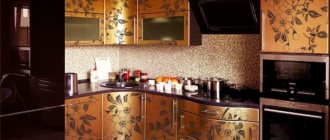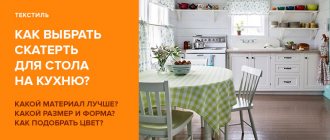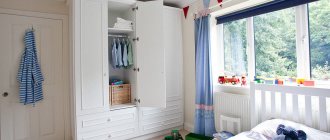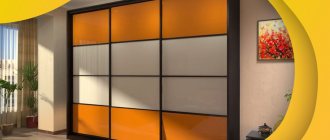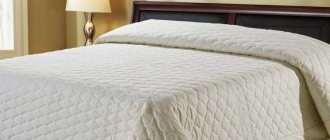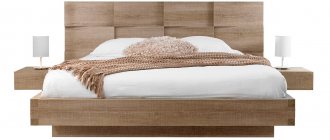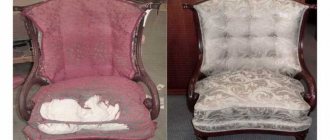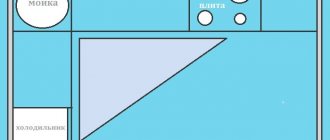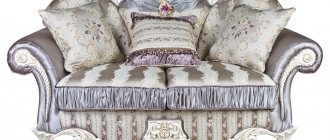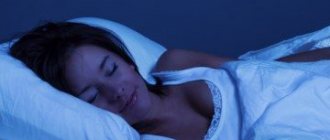Until recently, any wardrobe capable of containing the wardrobe of an entire family was large, bulky and heavy. Such characteristics could hardly be called advantages, so modern designers have invented an interesting alternative - a fabric wardrobe - a relatively new phenomenon in the furniture market. The lightweight, collapsible design is in no way inferior in functionality to traditional options made from fiberboard. The model weighs several kilograms and, when folded, fits into a small suitcase. But the most important thing is that with such modest parameters, fabric furniture is very roomy.
Features and Disadvantages
A cabinet made of fabric on a frame is an alternative to the classic version made of wood, fiber boards, and plastic. It is a fabric cover with walls and shelves, stretched over a collapsible base made of light tubes. In terms of content, this model does not differ from a traditional cabinet. Inside there can be numerous shelves and a crossbar for placing a wardrobe on hangers, or one of the two - depending on the purpose of the furniture.
The fabric cabinet is designed for storing clothes, home textiles, linen, kitchen utensils, papers, and toys. Modern options are made from different materials, any colors and sizes. This piece of furniture can fit into any room.
Most people are skeptical about the new model, so the predominantly fabric option is seen as temporary: for example, immediately after moving to a new apartment, while it is not yet possible to purchase wooden furniture, or for installation in rented housing. However, such a cabinet is quite suitable as a permanent setting for a nursery, cottage, kitchen, or hallway.
The product is characterized by a number of advantages:
- Easy to install and dismantle. You can assemble, install, and disassemble furniture without complex tools, at any level of physical strength.
- Easy to transport. The assembled cabinet fits into a suitcase and weighs almost nothing. You can take it with you on trips.
- Financial inclusion. A person with any income level can afford such a purchase.
- Hassle-free care. The dirty cover is removed from the frame and washed in an automatic washing machine.
- Variety of options. Colors, shapes, and purposes allow you to choose a model for rooms of different sizes.
Ease of care is also a disadvantage. It is enough to wipe a regular cabinet with a cloth; a fabric one will have to be washed. To remove the cover from the frame, you will need to lay out all your things. There are other disadvantages:
- the material will become unusable faster than MDF or wood;
- Such furniture is difficult to fit into a classic interior.
A fabric wardrobe is considered the best option for a child's room - the child grows quickly, and as he gets older, the interior of his room changes quickly and without unnecessary financial costs.
Manufacturing technologies
There are several ways:
- Processing using a sandblasting unit.
- Chemical treatment.
- Pasting with special film.
- Lakomat.
Changing the structure of a glass surface using sandblasting
– the most common matting technology. The flow of sand removes the top surface of ordinary glass, and it loses its transparency. By changing the fraction of abrasive material and the pressure in the unit, you can change the roughness and degree of dullness.
There are several types of sandblasting glass:
- Planar.
- Colored.
- Tinted.
- Three-dimensional.
Glass etching to form an opaque glass surface is done using hydrofluoric acid. The matting paste covers the unprotected parts of the product through a stencil, and after a certain time it is removed and the glass surface is washed.
Areas treated with paste become matte.
Compared to sandblasting, sandblasting makes the surface less rough and does not require a protective coating after treatment.
In production, the glass surface is completely treated with matting substances, which makes it possible to create an ideal matte surface, which is called satinato.
Frosted films for glass
Film finishing
- the most economical way. The glass is covered with a film with shading, patterns or designs.
The disadvantage of this method of matting is the need to use the finished glass under special conditions - friction or heavy wetting of the surface should not be allowed.
Lakomat
– a special matting method. The surface is covered with a layer of matting varnish; it can be either translucent or white.
When coating glass with varnish, the following tools are needed:
- rubber trims;
- rollers;
- brushes;
This method requires special care and accuracy.
Original products with an unusual effect are obtained by changing the glass surface using laser radiation. There is a method of processing glass using surface detonation and using metal spraying using a plasma installation; with this processing, small drops of molten metal heat the glass to a high temperature.
As a result, microchips and very small cracks form on the surface of the glass. They create matte areas. But such matting technologies are practically not used due to the high price of equipment and the complexity of the manufacturing process.
Types of glass that are used in the manufacture of frosted products:
- mirror;
- tinted;
- painted;
- hardened;
- triplex;
- polished;
Classification
There are various frame cabinets made of fabric. In addition to colors, type of material, sizes, they differ in purpose and method of closing. It’s not always possible to quickly navigate the wide range of models in the store, so it’s worth understanding the classifications in advance.
Classification of combined cabinets, design features
By purpose
The purpose of furniture depends on where it is located and for what purpose. The following options are available:
- Clothes. Traditional model for bedroom, dressing room. It is a design with a crossbar for hangers. In addition to compartments for dresses and suits, there may be shelves, drawers for linen, bedding, bath accessories, and wrinkle-resistant clothing. Fastens with a zipper, Velcro, and can be closed with curtains.
- Shoe. An option for both the hallway and the loggia for storing seasonal, unused shoes. For production, waterproof, dirt-repellent, impregnated fabric is used. The cabinet can be open (shoe shelf) or zippered (for seasonal storage or as protection from pets).
- Children's. Bright colors and easy-to-clean fabric are its distinctive features. There are many design options - wardrobe, toy rack, combined. Can be open or closed. Often equipped with additional pockets for small items.
The most versatile is a shelving cabinet, also known as a pencil case. Used in different rooms. Suitable for storing linen, bedding, home textiles, toys, books, papers and other household items. It can be open and closed, rectangular and cylindrical. Depending on the material, filling, color, it is used in the kitchen, children's room, living room, hallway, bathroom.
Children's
Shoe
Clothes
By closing method
According to this parameter, a fabric cabinet can be:
- Completely open. For the kitchen, living room, hallway, children's room. They store things there that need not be hidden from prying eyes.
- With curtains. This model can be quickly opened and closed. It comes in the form of a wardrobe, kitchen rack, wardrobe. Curtains can be additionally equipped with ties or Velcro. Models are available with regular or roller blinds.
- With ties. A cozy option for a Provence style kitchen or cottage. Suitable for the bedroom too.
- With a zipper. Practical modification. In the bathroom, such a cabinet made of waterproof fabric will reliably protect things from moisture. A coat with a zipper will prevent dust and sunlight from getting on your clothes.
- Velcro. Practical, but will not protect against moisture. It is convenient for children to open and close the structure.
There are combined models of fabric cabinets, for example, when the upper part of the pencil case is completely open, and the lower part is closed with a curtain.
With strings
Velcro
With a zipper
Open
With curtains
How a folding fabric wardrobe works - types of designs
When choosing a fabric wardrobe, you need to know how it is designed. What types of cases are there and how to open them. How many elements does the frame consist of? How are the parts connected? What types of storage systems are there inside, based on the different purposes of the prefabricated model. All these questions should be clarified before purchasing a transforming cabinet.
Fabric cabinet frame
A rigid frame is the basis of the entire structure. Its reliability depends on the material used to produce the cabinet. Therefore, when making prefabricated models, hollow metal tubes are used. Thanks to the voids in the middle, they are light but quite reliable. Plastic or metal-plastic tubes also serve as a strong base for the cabinet, having even less weight. Connecting elements are included. Plastic parts and metal screws are used. The legs at the end have rubber pads that prevent scratching the floor surface. Models with wheels are convenient; they can be easily moved away from the wall while cleaning.
Do not overload the folding closet. It is better to keep the condition of the fasteners and the frame itself under control to avoid breakage.
Internal filling
The internal contents of different models of folding cabinets may differ. Its main determining factor is the purpose of the fabric module. The main storage sections are:
- shelves - can occupy the entire closet or some part. They are fabric stretched over frame elements. The material can withstand not only textiles; shoe cabinet models are in great demand.
- rods – serve as hanger holders. Reliable fastening and material allow you to hang dresses, shirts, even outerwear.
- pockets – located inside or outside the wardrobe. Helps in storing small items.
Different storage sections in large cabinets can be separated by partitions. Some models do without internal textile walls.
Options for opening fabric cabinets
Methods for closing a fabric cabinet:
- with a zipper. They are considered more airtight: dust and moisture do not get inside.
- with Velcro. The fabric doors close and open quickly and are convenient for children to use.
- with ties. Quiet operation is a plus. The time required to tie or untie is a small minus.
- with curtains. The model is suitable for a summer or country house. The configuration is not as sealed, but is convenient for frequent use.
No less popular is a folding wardrobe, where fabric doors roll to the sides or up. There they are fixed with Velcro or ties for easy searching and putting things away. Completely open models are the most suitable option for frequent use of their contents.
Fabric cover for folding wardrobe
When choosing a fabric wardrobe, you need to pay attention to the material from which the cover is made. It must be durable, impermeable to moisture and dust, and dirt-repellent. Not only ordinary fabric is used here. Layers with the addition of synthetic fibers make the textile part of the cabinet unaffected by:
- to fading under the sun's rays;
- to loss of color and shedding during washing. The dried fabric should be free of stains and streaks;
- to mechanical damage when the cabinet is loaded. Fabric shelves must be able to withstand shoes and stacks of clothes, and the walls must retain their shape even if the module is too full.
Despite the claims of cover manufacturers, the fabric should not be constantly exposed to high humidity. Therefore, if you place folding furniture in the bathroom, it is better to keep it away from direct contact with water. It will also fit very well on a balcony or in a cool corridor.
Manufacturing materials
The main material for the manufacture of this piece of furniture is fabric, synthetic raw materials with the following characteristics:
- ability to keep its shape, no deformation under the influence of heavy objects on shelves;
- repels water, dirt, and dust; for this purpose, treatment with special impregnations is used;
- strength, resistance to mechanical wear;
- color fastness - does not fade when washed, does not fade in the sun;
- ease of cleaning.
Types of wardrobes, photos and internal contents
Most often, manufacturers use:
- Woven polyester is an inexpensive synthetic with low density and elasticity. It is recommended to wash this cover only by hand in cold water, otherwise the fabric will wrinkle and ironing it is very difficult.
- Polyethylene vinyl acetate (PEVA) is a dense material with continuous thread dyeing, which allows it not to lose its original color even after repeated washings.
- Taffeta is a highly wear-resistant woven fabric made from nylon and polyester fibers.
- Oxford is a dense material made of PVC fibers. The fabric is moisture-resistant and durable, characterized by a long service life.
Qualities such as water resistance and strength depend on the purpose of the furniture. In the bathroom, protection from moisture is more important, in the hallway - dirt-repellent properties, in the nursery - hassle-free cleaning.
The requirements for the frame material are simple: strength, lightness, flexibility, resistance to rust. Usually these are tubes or slats made of metal, plastic, or metal-plastic. They are also used to make the basis for shelves, drawers, and fasteners for curtains. The crossbar for placing hangers in a wardrobe must be especially strong. The lower part of the structure is on legs. For ease of movement, they are equipped with wheels or rubber pads so as not to scratch the floor.
Methods for calculating material for banners
There are two ways to calculate how much fabric you need. The first time, measure the length and width of the furniture being repaired, add the data and multiply by two - this will be the required area. For example, if the length of the object is 2 m and the width is 0.5 m, then to reupholster it you will have to buy 5 linear meters. But this method gives an approximate result, so a lot of material may remain after work.
The second way to calculate the amount of matter is more accurate than the first:
- Remove the old upholstery.
- Measure every detail with a tape measure: seat, back, armrests. If the elements have a complex shape, then take into account the maximum width and length of these parts.
- Schematically draw the object on a sheet of paper, sign the results of its measurements, adding 4-5 cm for hems and seams.
According to the second method, the width of the cut should be equal to the widest part of the furniture. Length – the sum of the results of the vertical lengths of all elements. We also recommend adding another 10-15% to the final length - margin for edging, the need to combine patterns, colors, etc.
Care
More intensely than on regular glass, any dirt is more noticeable on frosted glass, even fingerprints are clearly visible. It is easier to remove them immediately after they appear - you need to wipe the contaminated area of the surface with a slightly moistened microfiber cloth.
Serious stains, such as those caused by grease, can be removed.
Such glass must be occasionally wiped with a piece of natural suede and washed with heated water and a small amount of vinegar. After this treatment, the cleaned surface is dried using microfiber.
Another option for cleaning a frosted glass surface can be treatment with a composition of several spoons of powdered chalk and 200 grams. clean water. The mixture is applied with a piece of rag to the glass surface, and when it dries, it is wiped off with newsprint.
Heavy contamination must be removed using ammonia, but it smells strong and unpleasant, for this reason, during such treatment it is necessary to intensively ventilate the room.
Self-made frosted glass can become a true work of art, and with the help of timely care, the beauty of the product will last for a long time.
Nuances of care
A feature that every fabric cabinet has is easy disassembly. If cleaning is necessary, the fabric can be removed from the frame without unnecessary complications. Wash the material once or twice a year or when soiled. Despite the processing and impregnation of the fabric, it still gets dirty over time and accumulates dust. Washing is carried out manually or using a conventional machine, which depends on the characteristics of the fabric.
Types of cabinets for icons, popular options for decorating furniture
Regular care involves cleaning the furniture from dust. To prevent it from accumulating on fabric surfaces, they are treated with an antistatic agent. It is better to remove dirt immediately, otherwise there is a risk that they will remain after washing.
It is important to monitor the integrity of the frame, connecting parts, and fasteners. If corrosion appears, treatment should be carried out; if it becomes loose, loose connections should be tightened. You cannot put things inside that are too heavy, exceeding the permissible weight, as this will quickly damage the furniture.
With proper care, a fabric wardrobe will last for many years. This is an excellent option for those who like to move, residents of rented housing, students, and summer residents. And also all those who value practical, multifunctional and unusual things.
Matte film
Matte self-adhesive film, which is easy to use, is also in demand. It is used to correct the flow of light through the glass of the door leaf into the room and is used to partially hide the visibility inside the room. Matte film serves as a replacement for sandblasted glass. Available in white, grey, blue, silver and bronze.
Another advantage of this finish is that it helps to hide dirt on the glass, including fingerprints, which is important for families with small children.
Properties of decorative film:
- Gives the door a sophisticated and attractive look.
- Protects against flying fragments when glass is damaged.
- It has soundproofing properties, which depend on the strength of the material.
- Made from natural environmentally friendly materials.
- Increases the resistance of glass to high temperatures, which is important in case of fire.
- Retains heat and reduces energy consumption in winter.
- Maintains the coolness that people so need in the summer heat.
- If you have no desire to change the old door leaf, you can transform it with a new surface decor.
